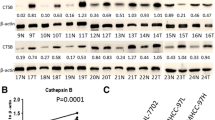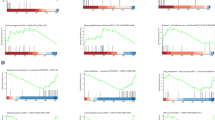Abstract
Extracellular matrix protein 1 (ECM1) is a glycoprotein involved in a number of biologic processes. To investigate the expression of ECM1 in hepatocellular carcinoma (HCC) and determine its correlation with tumor progression and prognosis, the expression levels of ECM1 in three HCC and one normal liver cell lines, tumor, and corresponding adjacent tissues from 18 HCC patients were analyzed by reverse transcription polymerase chain reaction (RT-PCR) and Western blotting. Immunohistochemistry assay was used to determine the expression of ECM1 in HCC and corresponding paracarcinomatous tissues from 77 patients. The results of Western blotting were consistent with the results from RT-PCR analysis of ECM1 mRNA expression. Among the four cell lines, the expression level in HCCLM3, which with the highest metastatic potential, was significantly higher than that with lower (P < 0.05); while ECM1 expression was not detected in normal liver cell line. Expression level of ECM1 was significantly increased in HCC compared with adjacent and normal liver tissues (P < 0.05). Immunohistochemically, the expression of ECM1 in HCC was judged to be positive in 57 (74.0%) cases, significantly higher than that in corresponding paracarcinomatous tissues (P < 0.01), and it was associated with tumor size (P = 0.036), number of tumor nodules (P = 0.048), TNM stage (P = 0.029), and vascular invasion (P = 0.007). In particular, the expression of ECM1 was found to be an independent factor for predicting overall and disease-free survival of HCC. The expression level of ECM1 was associated with metastatic potential of HCC, and its abnormal expression may be used as a predictive factor of unfavorable prognosis and recurrence for HCC after surgery.





Similar content being viewed by others
References
Parkin DM, Bray F, Ferlay J, Pisani P. Global cancer statistics, 2002. CA Cancer J Clin. 2005;55:74–108.
He J, et al. Major causes of death among men and women in China. N Engl J Med. 2005;353:1124–34.
Bhalerao J, et al. Molecular cloning, characterization, and genetic mapping of the cDNA coding for a novel secretory protein of mouse. Demonstration of alternative splicing in skin and cartilage. J Biol Chem. 1995;270:16385–94.
Mathieu E, Meheus L, Raymackers J, Merregaert J. Characterization of the osteogenic stromal cell line MN7: identification of secreted MN7 proteins using two-dimensional polyacrylamide gel electrophoresis, western blotting, and microsequencing. J Bone Miner Res. 1994;9:903–13.
Smits P, et al. The human extracellular matrix gene 1 (ECM1): genomic structure, cDNA cloning, expression pattern, and chromosomal localization. Genomics. 1997;45:487–95.
Lal G, et al. Extracellular matrix 1 (ECM1) expression is a novel prognostic marker for poor long-term survival in breast cancer: a Hospital-based Cohort Study in Iowa. Ann Surg Oncol. 2009;16:2280–7.
Sercu S, Zhang L, Merregaert J. The extracellular matrix protein 1: its molecular interaction and implication in tumor progression. Cancer Invest. 2008;26:375–84.
Lal G, et al. ECM1 expression in thyroid tumors–a comparison of real-time RT-PCR and IHC. J Surg Res. 2008;149:62–8.
Han Z, et al. The relationship between the extracellular matrix and the angiogenesis and metastasis of laryngeal carcinoma. ORL J Otorhinolaryngol Relat Spec. 2008;70:352–8.
Han B, et al. Homozygous missense mutation in the ECM1 gene in Chinese siblings with lipoid proteinosis. Acta Derm Venereol. 2007;87:387–9.
Sander CS, et al. Expression of extracellular matrix protein 1 (ECM1) in human skin is decreased by age and increased upon ultraviolet exposure. Br J Dermatol. 2006;154:218–24.
Kebebew E, Peng M, Reiff E, McMillan A. Diagnostic and extent of disease multigene assay for malignant thyroid neoplasms. Cancer. 2006;106:2592–7.
Lupo I, et al. A novel mutation of the extracellular matrix protein 1 gene (ECM1) in a patient with lipoid proteinosis (Urbach-Wiethe disease) from Sicily. Br J Dermatol. 2005;153:1019–22.
Kebebew E, et al. ECM1 and TMPRSS4 are diagnostic markers of malignant thyroid neoplasms and improve the accuracy of fine needle aspiration biopsy. Ann Surg. 2005;242:353–61. (discussion 61-3).
Pauws E, et al. Genes differentially expressed in thyroid carcinoma identified by comparison of SAGE expression profiles. FASEB J. 2004;18:560–1.
Wang L, et al. Extracellular matrix protein 1 (ECM1) is over-expressed in malignant epithelial tumors. Cancer Lett. 2003;200:57–67.
Oyama N, et al. Autoantibodies to extracellular matrix protein 1 in lichen sclerosus. Lancet. 2003;362:118–23.
Han Z, et al. Extracellular matrix protein 1 (ECM1) has angiogenic properties and is expressed by breast tumor cells. FASEB J. 2001;15:988–94.
Deckers MM, et al. Recombinant human extracellular matrix protein 1 inhibits alkaline phosphatase activity and mineralization of mouse embryonic metatarsals in vitro. Bone. 2001;28:14–20.
Li Y, et al. Establishment of a hepatocellular carcinoma cell line with unique metastatic characteristics through in vivo selection and screening for metastasis-related genes through cDNA microarray. J Cancer Res Clin Oncol. 2003;129:43–51.
Li Y, et al. Establishment of cell clones with different metastatic potential from the metastatic hepatocellular carcinoma cell line MHCC97. World J Gastroenterol. 2001;7:630–6.
Edmondson HA, Steiner PE. Primary carcinoma of the liver: a study of 100 cases among 48, 900 necropsies. Cancer. 1954;7:462–503.
Acknowledgments
This study was supported by the National Natural Science Foundation of China (No. 30772097 and No. 30972892), Anhui Provincial Natural Science Foundation (No. 070413073), the Science and Technological Fund of Anhui Province for Outstanding Youth (No. 08040106818), Anhui Provincial Natural Science Foundation of Institution of Higher Education (No. KJ2010B386), and the Anhui Provincial ‘115’ Industrial Innovation Programme.
Author information
Authors and Affiliations
Corresponding author
Additional information
Hao Chen and Wei-dong Jia contributed equally to this work as co-first authors.
Rights and permissions
About this article
Cite this article
Chen, H., Jia, WD., Li, JS. et al. Extracellular matrix protein 1, a novel prognostic factor, is associated with metastatic potential of hepatocellular carcinoma. Med Oncol 28 (Suppl 1), 318–325 (2011). https://doi.org/10.1007/s12032-010-9763-1
Received:
Accepted:
Published:
Issue Date:
DOI: https://doi.org/10.1007/s12032-010-9763-1




